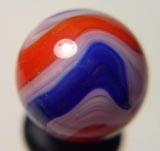Needle etched glass was an acid etching technique applied glassware, typically on thin-walled hand blown glass pieces. The techniques was most widely used in the 1920s, and is most typically found in stemware. Needle etch offered a less expensive, but still high quality alternative to hand cut lead crystal. Later made pressed glass pieces with more elaborate machine automated etched designs are found in the "elegant glass" category.
In the needle etching process, a glass blank was coated with wax. A skilled setter used a complex machine to carve a repeating pattern in the glass. The glass was set in place and slowly rotated while the machines needle traced the pattern into the wax. Once the pattern was complete, a second worker repaired any spots where the wax coating had been damaged by handling. Thereafter the piece was brought to the dipping room where an acid etcher immersed the ware in a hydrofluoric acid bath. The exposed cut design was eaten away by the acid, creating the fine groove pattern of this glass. The glass was then taken to a steamer to melt of the glass, then polished.
By the 1930s needle etched glass was supplanted by the easier and less costly to produce depression and pattern glass. Companies like Fostoria, Bryce, and other earlier makers manufactured the glass.



 Buy Akro Agate Popeye marbles on eBay!
Buy Akro Agate Popeye marbles on eBay!